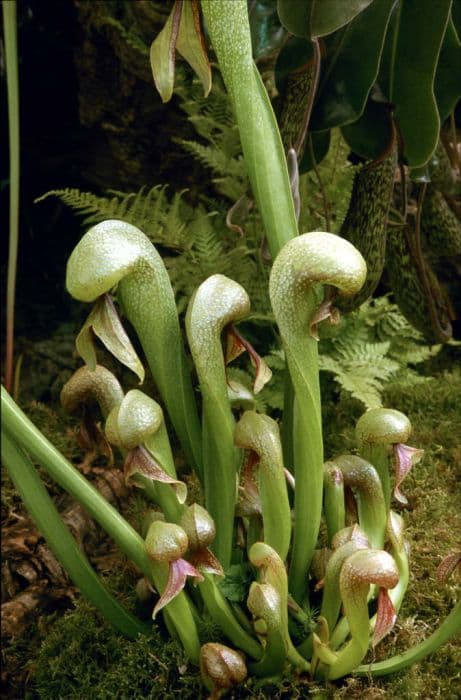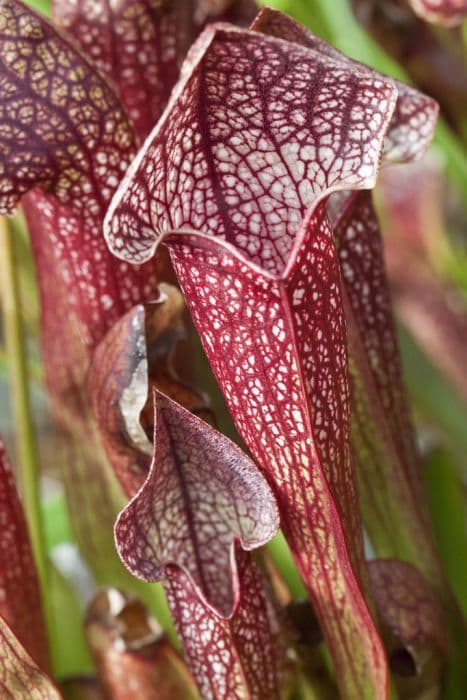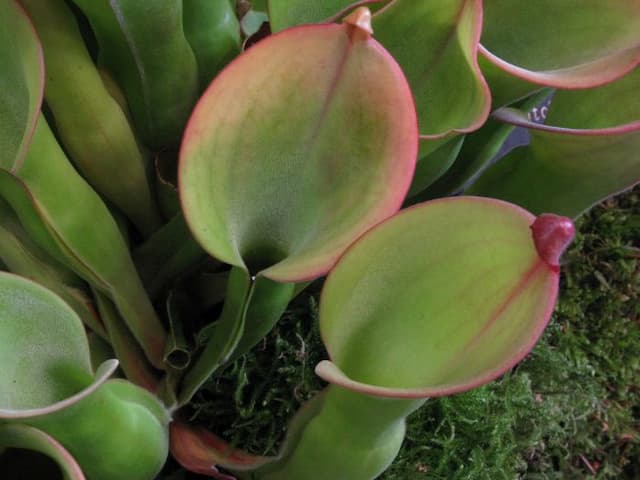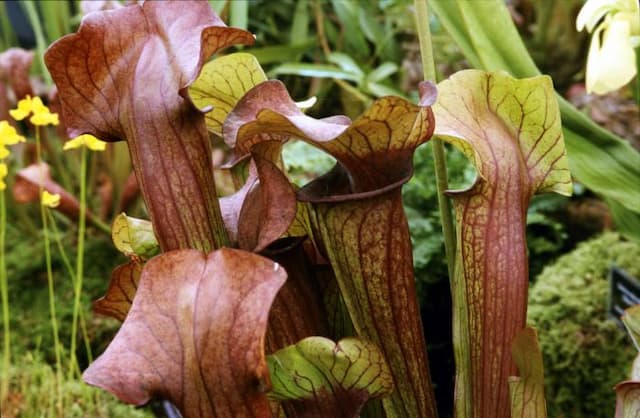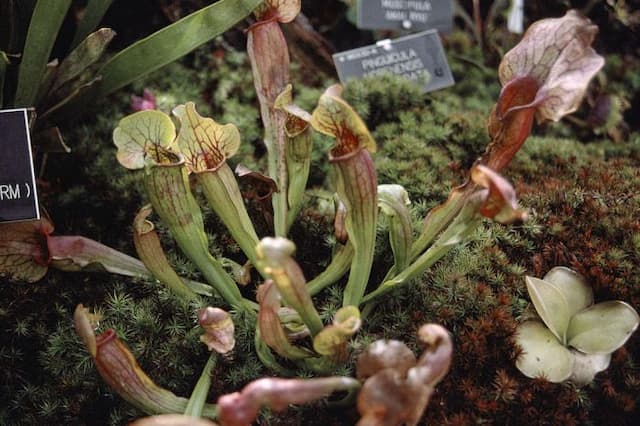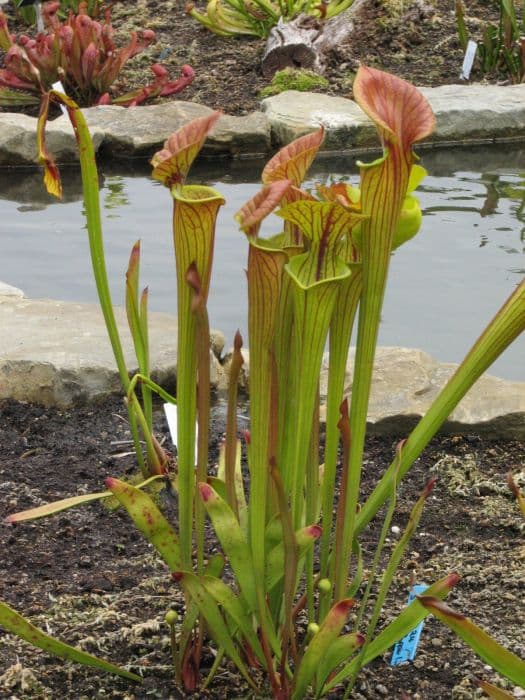Pitcher Plant Sarracenia 'Vogel'

ABOUT
Sarracenia 'Vogel', commonly known as a type of North American pitcher plant, is a carnivorous plant with a unique and visually striking appearance. The plant features a rosette of tubular, upright pitchers with a flared opening. Each pitcher is typically adorned with a pattern of veins and may exhibit a spectrum of colors ranging from green to deep red or purple, often with a gradient or mottled pattern. The pitchers are modified leaves designed to trap and digest insects, with a slippery interior and downward-facing hairs that prevent prey from escaping. The top of the pitcher forms a lid, known as the operculum, which overhangs the opening to protect the interior from excess rainwater while still allowing insects to enter. Sarracenia 'Vogel' also produces flowers that are held above the pitchers on separate, tall stems. The flowers have an unusual appearance, dangling upside down, and can be as vividly colored as the pitchers themselves, sometimes displaying hues similar to the pitchers or in contrasting shades. The petals may curve back and reveal a central, umbrella-like structure holding the reproductive parts. In summary, the striking pitchers with their intricate veining and diverse colors, combined with the unique, nodding flowers, give Sarracenia 'Vogel' a distinctive appearance that sets it apart from typical foliage plants. Its carnivorous nature adds to its allure and the adaptability it exhibits in capturing and digesting prey is a fascinating aspect of its appearance and functionality.
About this plant
 Names
NamesFamily
Sarraceniaceae
Synonyms
Vogel's Pitcher Plant
Common names
Sarracenia 'Vogel'.
 Toxicity
ToxicityTo humans
The Sarracenia 'Vogel', more commonly known as the pitcher plant, is not considered toxic to humans. Generally, these carnivorous plants do not pose a threat if touched or handled. However, ingestion of any part of the pitcher plant is not advisable, as it could potentially cause gastrointestinal discomfort or irritation due to the plant's digestive enzymes and bacteria, although serious poisoning or life-threatening consequences are rare.
To pets
The pitcher plant is also not known to be toxic to pets. Like with humans, these plants are carnivorous but not harmful to cats, dogs, or other household pets through casual contact. Nevertheless, it's always best to discourage pets from chewing on or ingesting plants, as the digestive fluids and possible bacteria in the pitcher plant could cause mild gastrointestinal upset, although severe poisoning is unlikely.
 Characteristics
CharacteristicsLife cycle
Perennials
Foliage type
Evergreen
Color of leaves
Varies
Flower color
Varies
Height
1-3 feet (0.3-0.9 meters)
Spread
1-2 feet (0.3-0.6 meters)
Plant type
Herb
Hardiness zones
6
Native area
North America
Benefits
 General Benefits
General Benefits- Attracts Wildlife: Sarracenia 'Vogel' can attract insects, providing food for birds and other insectivores.
- Aesthetic Appeal: With its unique pitcher-like leaves, this carnivorous plant adds an exotic touch to gardens or collections.
- Educational Interest: It can be used as an educational tool to demonstrate carnivorous plant behaviors and ecosystems.
- Low Maintenance: Once established in the correct conditions, it requires minimal care beyond ensuring adequate moisture.
- Pest Control: As a carnivorous plant, it naturally reduces the number of insects in its vicinity.
- Conservation: Cultivating Sarracenia 'Vogel' can contribute to the conservation of carnivorous plants, as many species are threatened in the wild.
- Hobby Cultivation: It is a popular choice among plant enthusiasts who enjoy cultivating and breeding carnivorous plants.
- Garden Variety: Adds diversity to plant collections and can be a centerpiece in a carnivorous plant garden setup.
 Medical Properties
Medical PropertiesThis plant is not used for medical purposes.
 Air-purifying Qualities
Air-purifying QualitiesThis plant is not specifically known for air purifying qualities.
 Other Uses
Other Uses- Ornamental Display: The pitcher plant's unique shape and vibrant colors make it a striking addition to terrariums and botanical gardens.
- Photography Subject: Its unusual form and vivid hues make it a popular subject for photographers, especially those specializing in macro and nature photography.
- Educational Tool: Biology teachers often use pitcher plants like the Sarracenia 'Vogel' to explain carnivorous plant mechanisms and plant adaptation in lessons.
- Pest Control: When kept in greenhouses, these plants can help control populations of small insects naturally, reducing the need for chemical pest control.
- Art Inspiration: Artists may draw inspiration from the unique aesthetic of the pitcher plant for works including painting, sculpture, and textile design.
- Collector's Item: Due to the numerous hybrids and species, including the pitcher plant in personal plant collections has become a hobby for many enthusiasts.
- Science Research: The pitcher plant is used in scientific research to study carnivorous plant evolution and ecology.
- Eco-Friendly Gifts: Small pitcher plants can make ecological and sustainable gifts for friends and family who appreciate unique flora.
- Water Measurement Tool: In some educational settings, the amount of water collected in the pitchers might be used for demonstrating natural water collection and retention.
- Live Insect Indicator: The health and activity of pitcher plants can indirectly indicate the presence and abundance of certain insects in a given area.
Interesting Facts
 Feng Shui
Feng ShuiThe Pitcher Plant is not used in Feng Shui practice.
 Zodiac Sign Compitability
Zodiac Sign CompitabilityThe Pitcher Plant is not used in astrology practice.
 Plant Symbolism
Plant Symbolism- Mystery and Uniqueness: The Sarracenia 'Vogel', or pitcher plant as it is commonly known, is a carnivorous plant with a unique method of trapping insects. Its distinctive appearance and insectivorous diet make it a symbol of the unusual and mysterious elements of the natural world.
- Adaptability: As this plant has adapted to thrive in nutrient-poor soil by evolving to consume insects, it represents the ability to adapt and make the most of available resources.
- Attraction and Deception: The pitcher plant lures its prey with bright colors and a tempting nectar, then traps the unsuspecting insects that slip down into its tubular leaves. It symbolizes the dual concepts of attraction and deception, as it is both alluring and deadly to its prey.
 Water
WaterThe Pitcher Plant requires consistent moisture and should be watered with about 1-2 inches of rainwater or distilled water per week to mimic its natural boggy habitat. Allow the potting medium to become slightly dry between waterings, but never let it dry out completely. To avoid mineral buildup, use water with low mineral content. During active growth in spring and summer, keep the water level steady by checking it 2-3 times a week and topping up as necessary. In winter, reduce watering to avoid waterlogging and root rot as the plant enters dormancy.
 Light
LightPitcher Plants thrive in full sun to partial shade, requiring direct sunlight for at least 6 hours a day to develop strong pitchers and vivid coloration. The ideal spot for your Pitcher Plant would be somewhere that receives bright, indirect light in the afternoon and direct sunlight in the morning. Protect them from the harshest midday sun to prevent leaf burn, especially during the hottest parts of the year.
 Temperature
TemperatureThe Pitcher Plant does best in temperatures ranging from 70 to 90 degrees Fahrenheit during its growing season, with a tolerance for occasional dips down to 32 degrees Fahrenheit. It can withstand a maximum temperature of about 95 degrees Fahrenheit. A drop in night time temperatures, ideally to the 50-70 degrees Fahrenheit range, is beneficial for encouraging healthy growth and pitcher formation.
 Pruning
PruningThe Pitcher Plant should be pruned to remove dead or decaying pitchers to promote healthy growth and prevent disease. Prune in late winter or early spring before the new growth starts. Use sterile scissors to cut off brown or damaged pitchers at the base. This annual pruning helps maintain the plants' vigor and appearance.
 Cleaning
CleaningAs needed
 Soil
SoilSarracenia 'Vogel', commonly known as pitcher plant, requires a well-draining, low-nutrient soil mix with a pH around 4.0 to 6.5. A common recipe includes sphagnum peat moss and perlite or sand in a 1:1 ratio. Do not use regular potting soil or fertilizers.
 Repotting
RepottingThe pitcher plant should be repotted every 2 to 3 years to refresh the soil and prevent mineral buildup. Repot in late winter or early spring before new growth begins.
 Humidity & Misting
Humidity & MistingPitcher plants thrive in high humidity conditions, preferably 50-80%. They benefit from a moist environment, which is crucial for their health and the development of their characteristic pitchers.
 Suitable locations
Suitable locationsIndoor
Keep pitcher plant in bright, indirect light with high humidity.
Outdoor
Place pitcher plant in partial sun with moist, well-draining soil.
Hardiness zone
5-9 USDA
 Life cycle
Life cycleThe Sarracenia 'Vogel', commonly known as a Pitcher plant, begins its life cycle as a seed, requiring a period of cold stratification to simulate winter conditions before germination. Once environmental conditions are right, including warmth and sufficient moisture, the seed germinates, and a small pitcher plant sprout emerges. The juvenile plant focuses on developing its root system and producing small pitchers, which are modified leaves used to attract and trap insects for nutrients. As the plant matures, it produces larger and more complex pitchers with attractive colors and patterns to increase its insect-trapping efficiency. Seasonal changes influence the growth cycle, with the plant entering a dormancy period during the colder months, reducing its growth and metabolic activity, and resuming vigorous growth in the spring. In the reproductive stage, the Pitcher plant will produce flowers on tall stalks separate from the pitchers, intending to attract pollinators and set seed for the continuation of the species.
 Propogation
PropogationPropogation time
Spring-Early Summer
The Sarracenia 'Vogel', commonly known as the pitcher plant, is typically propagated through division, which is best done in late winter to early spring before the plant enters its active growing phase. To carry out division, a mature plant must be carefully removed from its pot and the soil gently washed away from the roots. The clumps of growth, or rhizomes, can then be divided by hand or cut apart using a sharp knife, ensuring that each section has at least one growth point, known as a crown. After division, the sections can be potted in separate containers filled with appropriate soil mix, which should be kept moist but not waterlogged to promote root development. The new plants will usually adapt quickly and resume growth as the growing season progresses.
